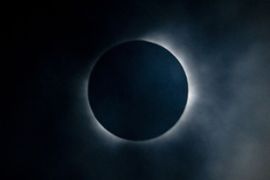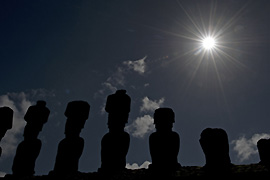Eclipse wows Easter Island
Tourists and scientists flock to historic site for best viewing conditions.

The moon’s shadow then swept across the South Pacific, darkening skies over the Cook Islands before cloaking Easter Island at around 2:11 pm where crowds broke into applause.
The eclipse then finished with a pass across southern Chile and Argentina, where it came to an end at 2052 GMT, just before nightfall in Patagonia.
“It was like being in the stadium at night with artificial light. It was like being in a dark room with a 10-watt bulb,” local Easter Island official Francisco Haoa told the AFP news agency.
 |
| Thousands of tourists flocked to Easter Island to watch the spectacle [AFP] |
“It started with a shadow. The skies were perfectly blue, with lots of wind that chased away the clouds. Everyone applauded.”
With thousands of visitors descending on the island, authorities had increased security for the eclipse, especially around key heritage sites including the territory’s famous World Heritage-listed stone statues, or moai, believed to be around 3,000-years-old.
The island was deemed by astronomers the best place to witness Sunday’s eclipse generated by the alignment of sun, moon and Earth for a fleeting four minutes and 41 seconds.
Although the sun is 400 times wider than the moon, it is also 400 times farther away.
Because of that symmetry, the lunar umbra, or shadow, that falls on the face of the Earth is exactly wide enough to cover the face of the sun.
For scientists the eclipse offers a rare opportunity to study the sun’s outer edge, or corona, that extends more than a million kilometres from the sun’s surface.
Solar storms in the corona can affect space weather which in turn can have an impact on Earth as the ejected material smashes into the planet’s magnetic field.
“The corona actually extends way out into space and we can see what we call ‘coronal mass ejections’ which are these huge massive amounts of material being blown away from the sun at millions of miles an hour,” Holly Gilbert, a NASA astrophysicist, told the Associated Press news agency.
A new round of solar storms is building up to a projected maximum period of activity in about four years and could potentially affect electrical systems, satellite communications and some computer networks.